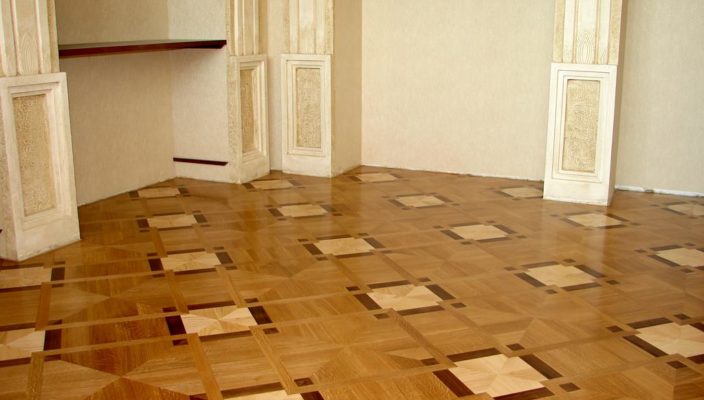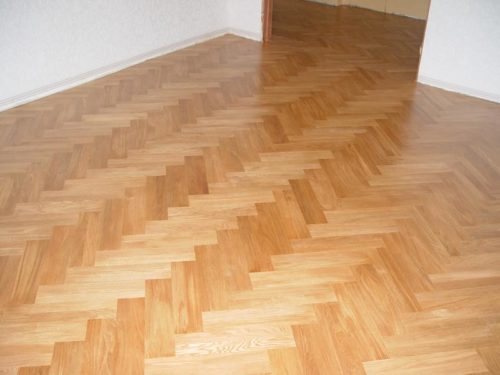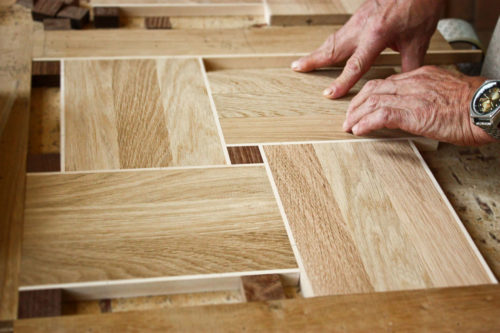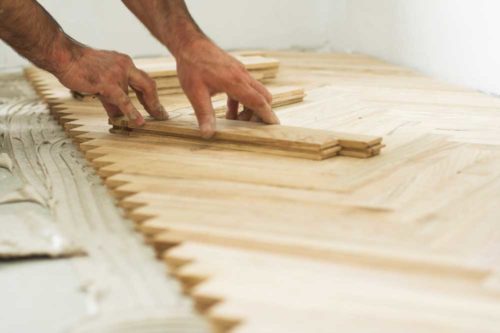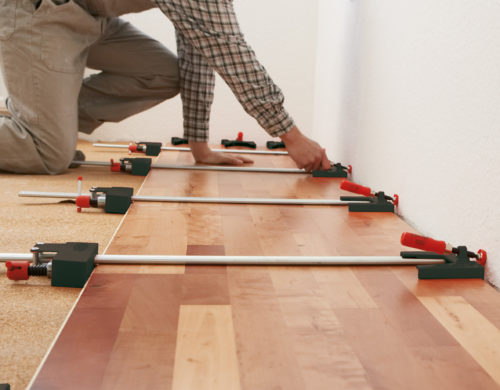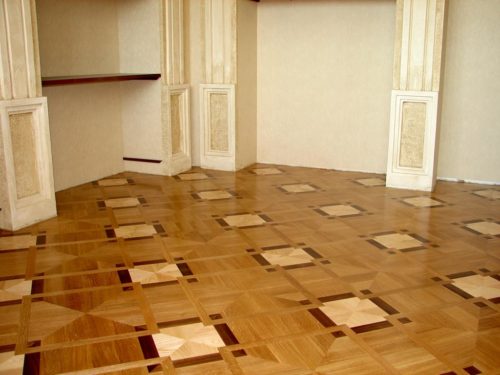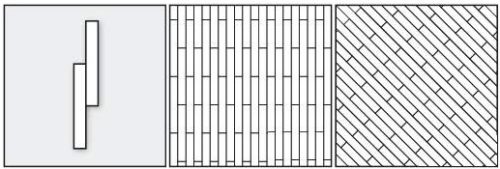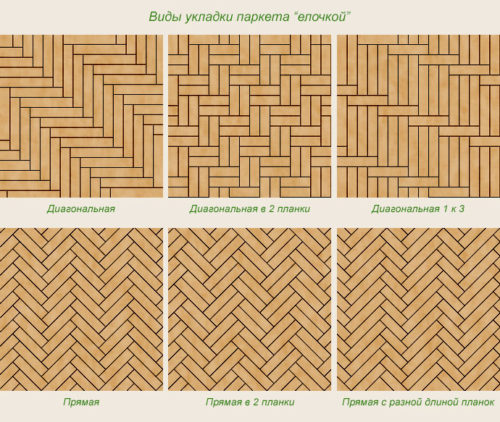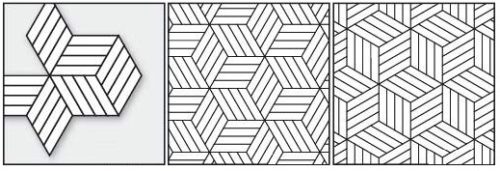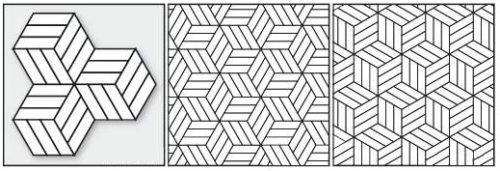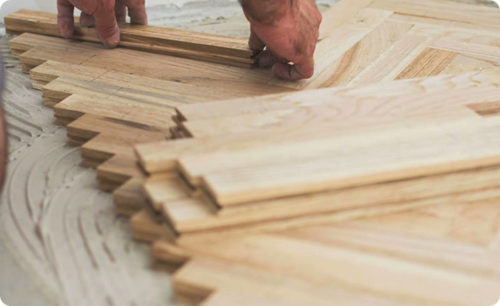Parquet applied to facing floors for quite a long time. It is enough to remember the luxurious palace floors, eliminated by a parquet board. Today there are a huge variety of varieties of this material according to the type, type, invoice, operational characteristics. Given this variety of products in the building materials market, the parquet today can purchase any owner of the house or apartment. Moreover, the pricing policy for this material is also in a rather wide range, so it can even buy those who wish to perform "budget" repairs. In addition, to save when carrying out facing works, it is still possible if you perform the installation of parquet with your own hands. Next, the article will feature tips from the flooring specialists.
Content
Advantages and disadvantages of parquet
Before crossing the installation work, consider the advantages and disadvantages of this material. So, the advantages of parquet can be attributed:
- Parquet is a natural material. Since today, many household owners give preference to natural materials, the parquet still does not lose their relevance among floor coverings.
- Resistance to mechanical damage.
- Good performance characteristics.
- Parquet strips can be easily repaired, if necessary. In addition, the parquet is perfectly renovated.
- Environmental purity. Since parquet belongs to a number of natural materials, it is environmentally friendly and safe. Such a coating can be laid in rooms where small children are.
- Respectable and luxurious appearance. Parquet is truly beautiful outdoor coating. Today there are many varieties of this material, so that the parquet will be aesthetically watching in any room.
The disadvantages of this material are also available. These include the following:
- Sensitivity to elevated moisture level. This material is non-fatty. Parquet can not be mounted indoors where there is an increased level of humidity.
- A fairly high value of the material. This coating has a very beautiful appearance.
- The complexity of the installation of the coating.
- Behind the laid parquet needed additional care.
Types and Characteristics of Parquet
Depending on the type of material, the laying scheme of the parquet is different. Most often, the following types of coverage are used during the repair:
- Parquet. This is a "budget" coating option. These parquet strips have a small length - 25-50 cm. The product width is no more than 8 cm. The height of the parquet slats is 1.5-2 cm.
- Board from the array. These are long boards made from a solid wood array. They are distinguished by good performance characteristics, wear-resistance, maintainability. The service life of such a coating with proper care reaches 80-100 years.
- Parquet board. The length of one parquet strip reaches 2.2 m, width - 15-20 cm, thickness 10-20 mm.
A parquet board has the following features:
- High strength. The strength indicators are achieved due to the unique structure of the wood (perpendicular location of the fibers).
- A parquet board is not so sensitive to moisture drops, like a piece parquet. Basically, the excess moisture is absorbed by the extreme layers of the material without destroying it the middle. Therefore, it is possible to lay such a parquet in the kitchen.
- Three-layer parquet boards have a relatively low price. In any case, the cost is lower than that of the array boards. A decrease in the cost of material due to the combination of various varieties of wood array is achieved. Most often, when producing a board, coniferous and deciduous types of wood are combined in its structure.
- The service life of the parquet board with proper care reaches 45-50 years.
In order to simplify the process of laying the coating, we produce parquet modules (blocks) in the structure of which parquet planks are already collected in a single drawing. To form such blocks, the boards with similar operational characteristics are selected so that the material "felt" the material is equally.
Due to the fact that the modular parquet is produced in the form of bulk blocks, its laying is performed on a simpler technique than the installation of piece parquet slats. Initially, the basic base is prepared, and the module is already attached to it using glue.
On the quality of the parquet affects how its upper layer is processed. There are two options:
- Partial grinding of wooden coating.
- Full surface treatment parquet strip.
If parquet is purchased with complete surface treatment, the installation of such a coating can be performed in a shorter period, rather than when laying slats with partial grinding. However, the cost of the treated parquet is quite high.
There are several varieties of the parquet board:
- Selected parquet (select). Such strips have clear and smooth edges of the cut, so when laying this coating, it is possible to obtain one-piece and homogeneous flooring, without jams and gaps.
- Natural parquet (trend). These planks have not such clear and even edges as the previous material grade, so when it is laying it is possible for small gaps in the joints. However, this material grade is still calculated to high-quality coatings, since parquet strips are selected in this case by color shade.
- Rustic (Terra). This type of parquet refers to "budget". In this case, parquet planks are not chosen in color shade and size, so when they are styling, the seams will be clearly visible. In addition, these boards can be detected by chips and swirls, so when laying the material, it is possible to have a certain percentage of discarded slats.
Instructions for laying parquet
The process of laying parquet can be divided into 3 stages:
- Preparation of premises and foundations.
- Laying parquet.
- The finish processing of the mounted coating.
Preparatory stage of parquet stacking
At this stage, you must perform the following:
- Preparation of the room. For this purpose, cleaning is carried out in the room where installation works are planned - dust, dirt, construction trash is cleaned. The old floor covering is dismantled. In addition, the room needs to create optimal temperature conditions - the temperature should be from 19 to 22 degrees.
- Installation and processing of the base. At this stage, a draft floor base is placed. The base surface is aligned and then covered with a layer of primer. Here it is necessary to provide how communication will be located, because perhaps you are planning the installation of a warm floor.
- Next, you should prepare parquet planks for installation. For this, the material is unpacking and left for a day "lie" in the room where repair work is planned. At the same time, the climatic conditions cannot be changed in the room, for example, in no case should not be carried out wet cleaning, because the change in humidity indicators can cause strain sizes. In addition, at this stage, the material is distributed in color and size. Planks are grouped by similar characteristics. Then the defective dies are selected. It is worth saying that the percentage of marriage should be foreseen at the stage of procurement of the material. So, it is recommended to acquire more parquet slats by 10%.
- Then you need to prepare the tools for laying parquet. Usually you will need to handle, level, roulette, wooden wedges, hammer.
Selection of Parquet Staying Fashion
There are the following package laying methods:
- "Drawing". In this case, parquet strips are placed with a displacement of several centimeters relative to previous dies.
- "Fir-tree." With such a laying scheme, one row of planks are stacked diagonally relative to another row. They jointly form a visual Christmas tree. Parquet in the desired direction is fixed on the adhesive solution.
- "Rhombus". Rhombus from parquet slats can be placed in a direct or diagonal direction. Usually, 4-5 parquet slats are in the structure of one "diamond".
- "Rhomb-star." In this way, the artistic parquet is stacked. In this case, parquet strips need to cut down diagonally, otherwise the desired drawing will not be turned out.
When the method of laying parquet is chosen, you should pick up the installation technology. There are several options for this:
- Installation on the screed. In this case, it is initially poured on the floor a concrete base. Concrete is moving, then ground. After that, you can upload parquet on it.
- Installation on lags. In this case, the wooden lags are first. They linged flat sheets of plywood. Sheet thickness - 9-12 mm. Then the plywood flooring is carried out by parquet.
- Laying on a draft floor. At the same time, natural wood is used for the edge of the draft coating. At the same time, it is necessary to ensure that the laid wooden surface is perfectly smooth and the "not played".
Parquet planning options:
- On glue. This uses a single-component or two-component adhesive mixture for parquet (for example, Bostik Tarbicol, ARTELIT brand glue). The glue is applied to the prepared and aligned base. After the planks are glued, it is impossible to walk on the surface until the adhesive solution is completely dry.
- On the brackets. In this case, parquet strips are stacked at a minimum distance from each other and fasten with the brackets.
- On nails. At the same time, nails are used to fix parquet slats.
Finish treatment of parquet
The finishing of parquet is the last stage of installation work. The final finish of the coating is carried out in several stages:
- Parquet squirrel. This procedure allows you to eliminate all the irregularities that arose during the installation of the coating. For cycling, special cycular machines will be required. One of them first remove rough defects, and the second - the coating is adjusted to an ideally even state.
- Putty work. The spacion mixture can be sealing cracks and gaps formed as a result of the violation of the carpet laying technology. The mixture can be prepared independently. For this, parquet dust is mixed with adhesive mortar.
- Tinting and varnishing parquet. Allows you to improve the appearance of the floor covering. Parquet varnish is applied to a dry and pre-polished surface. Enough parquet coat 3 thin layers of varnish.
At the final stage, a plinth installation is carried out after the finishing of the parquet.

